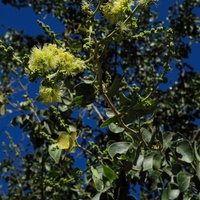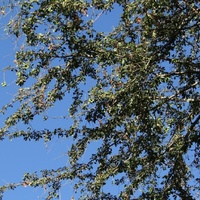Common name: Manila tamarind
Other common names: Blackbead, Jungle jalebi, Madras thorn, Opiuma
Description
Manila tamarind is a multi-purpose tree legume originating from Central America, its natural range extending from Sonora, in the far north of Mexico, to Panama and occurs there mostly in dry coastal areas.
It is a fast-growing small tree up to 25 m (82 ft), though is more typically 5 to 15 m (16 to 50 ft) tall.
The trunk is usually straight, slim and supports a wide-spreading crown of feathery foliage, the leaves consisting of two pairs of small, oblong leaflets. The leaflets emerge pinkish to reddish, then with age become dull green, on top darker than underneath. Although most remain on the tree, leaf-fall occurs as part of normal leaf exchange and is heaviest in areas with a long or pronounced dry season. A pair of slender, sharp spines arm the base of the leaf.
The flowers are small, tubular, greenish and have prominent, creamy-white stamens. They are borne tightly packed, some twenty to thirty in a cluster and with clusters grouped on flower-spikes arising at the sides and ends of the branches.
Flowering occurs in the dry season and, after pollination, gives rise to straight, slender, green seedpods that, as they lengthen, become coiled and curved. The seedpods also change colour as they mature, becoming reddish, and develop prominent ribbing, due to the seed enlarging inside the shell. The seed are oval, glossy black and covered with a thick pink and white pulp.
Use
Being a tree legume, Manila tamarind can fix nitrogen from the air in the soil, thereby enabling it to survive (and sometimes thrive) on nutrient-poor or thin soils. This has led to its widespread use in reforestation projects, particularly on degraded soil and sloping land, in efforts to minimise soil erosion and protect watershed areas.
It has also been widely planted in coastal areas as a street or landscape tree, for its compact size, shapely form, the shade it gives, as well as its tolerance to salty and alkaline soil and pronounced drought conditions. Its small leaves also make it popular in bonsai culture.
The pink-white pulp around the seed has a pleasing, sourish taste and is sometimes eaten fresh out-of-hand, but is more often used as a souring agent in food and to sour and flavour cold beverages.
The whole seedpods and leaves are highly palatable to livestock and are eagerly browsed on or are cut and harvested as feed, particularly for small ruminant livestock such as sheep and goats. The fresh-cut leaves have a high crude protein content of around 23% to 29% of their dry weight.
The flowers yield high-quality pollen collected by brood-rearing honeybees, as well as abundant nectar for honey production. It is reported as a major honey tree in Mexico, the Dominican Republic and southern Florida, in the United States. The pure, unadulterated honey is whitish, thin and has an excellent flavour.
Manila Tamarind produces a medium-weight wood, in the 600 to 650 kgs per cubic meter (37 to 40 lbs per cubic ft) range, with good natural resistance to rot and decay. This puts it in the durable hardwood class, suitable for use both indoors and out. The sapwood is yellowish and the heartwood reddish-brown.
However, the wood is not much used, due to its brittle nature and the relative scarcity of suitably sized logs. When available, they are sawn into beams and planks used in general construction, including post and poles, and for crates and boxes.
The bark on wounding yields a dark brown, transparent gum that is soluble in water, forming a mucilage suitable for use as a light adhesive, such as that used in paper-making.
General interest
Manila Tamarind is closely related to the Rain Tree (Samanea saman), which overlaps with it in its native range, in Central America, as well as in its utilisation as a shade tree and source of livestock forage and feed.
Climate
Grows naturally in sub-humid to moderately humid subtropical and lowland to mid-elevation tropical climates, generally in areas with annual lows of 17 to 25°C, annual highs of 27 to 35°C, annual rainfall of 400 to 2500 mm and a dry season of 3 to 8 months.
Growing
New plants can be started from seed or cuttings. The seed remain viable for up to six months under cold, dry storage and germinate within a week of sowing. Seed should be sown in a free-draining potting mix and the seedlings tending in a nursery for around three months, or until they are about 40 cm (1.3 ft) tall.
Manila Tamarind performs best on free-draining clay-loam, loam and sandy-loam soils of a moderately acid to slightly alkaline nature, generally with a pH of 5.5 to 7.5, and on sites with full sun exposure.
Problem features
Manila tamarind is assessed as a high weed risk species for Hawaii and Florida, respectively by the Hawaii Pacific Weed Risk Assessment (HPWRA) project and the IFAS Assessment of Non-Native Plants in Florida's Natural Areas.
The sharp spines at the base of the leaf can inflict injury on the unwary.
Where it grows
References
Books
-
Adams, C. D. 1972, Flowering plants of Jamaica, University of the West Indies, Mona, Greater Kingston
-
Crane, E., Walker, P. & Day, R. 1984, Directory of important world honey sources, International Bee Research Association, London
-
Francis, J. K. 1998, Tree species for planting in forest, rural, and urban areas of Puerto Rico, U.S. Department of Agriculture, Forest Service, International Institute of Tropical Forestry, Río Piedras, Puerto Rico
-
Francis, J. K. and Liogier, H. A. 1991, Naturalized exotic tree species in Puerto Rico, General technical report SO-82, USDA Forest Service, Southern Forest Experiment Station, New Orleans
-
Francis, J. K. et al. 2000, Silvics of Native and Exotic Trees of Puerto Rico and the Caribbean Islands, Technical Report IITF-15, USDA Forest Service, Rio Piedras, Puerto Rico
-
Gohl, B. 1981, Tropical Feeds : feed information summaries and nutritive values (Revised edition), Food and Agriculture Organization of the United Nations (FAO), Rome
-
Hocking, D. 1993, Trees for drylands, International Science Publisher, New York
-
Howes, F. N. 1949, Vegetable gums and resins, Chronica Botanica Company, Waltham, Massachusetts
-
Jensen, M. 1999, Trees commonly cultivated in Southeast Asia : an illustrated field guide, 2nd ed., Food and Agricultural Organisation of the United Nations (FAO) Regional Office for Asia and the Pacific (RAP), Bangkok
-
Jex-Blake, A. J. 1957, Gardening in East Africa : a practical handbook, 4th ed., Royal Kenya Horticultural Society, Longmans, Green and Company, London
-
Krishen, P. 2006, Trees of Delhi : a field guide, Dorling Kindersley Publishers, Delhi
-
Little, E. L. et al. 1964 and 1974, Common trees of Puerto Rico and the Virgin Islands (2 volumes), Forest Service, U.S. Department of Agriculture (USDA), Washington D.C.
-
Luna, R. K 1996, Plantation trees, International Book Distributors, Dehradun, Uttarakhand
-
Macmillan, H. F. 1943, Tropical planting and gardening : with special reference to Ceylon, 5th ed, Macmillan Publishing, London
-
Martin, F. M., et al. 1987, Perennial edible fruits of the tropics : an inventory, U.S. Dept. of Agriculture (USDA), Agricultural Research Service, U.S. Government Printing Office (GPO), Washington, D.C.
-
Nair, P. K. R. 1993, An introduction to agroforestry, International Centre for Research in Agroforestry (ICRAF), Kluwer Academic Publishers, Dordrecht
-
National Research Council (Board on Science and Technology for International Development) 1980, Firewood crops : shrub and tree species for energy production (Volume 1), The National Academies Press, Washington D. C.
-
Parrotta, J. A. 2001, Healing plants of peninsular India, CABI Publishing, Wallingford, Oxfordshire
-
Prasanna, P.V. 2012, Trees of Hyderabad: A Pictorial Guide, 1st ed., Botanical Survey of India (BSI), Indian Government Ministry of Environment and Forests, Kolkata
-
Randall, R. P. 2002, A global compendium of weeds, R.G. and F.J. Richardson Press, Melbourne
-
Randall, R. P. 2007, The introduced flora of Australia and its weed status, Cooperative Research Centre for Australian Weed Management, Glen Osmond, South Australia
-
Record, S. J. & Hess, R. W., 1972, Timbers of the New World, Yale University Press, New Haven, Connecticut & Arno Press, New York
-
Selvam, V. 2007, Trees and shrubs of the Maldives, Food and Agriculture Organisation (FAO) RAP publication (Maldives), Thammada Press Company Ltd., Bangkok
-
Sheikh M. I. 1993, Trees of Pakistan, USAID Forestry Planning and Development Project, Pictorial Printers, Islamabad
-
Vázquez, Y. C. 1999, Potentially valuable Mexican trees for ecological restoration and reforestation, Institute of Ecology, Database SNIB-REMIB-CONABIO, Project J084, Mexico
Articles, Journals, Reports and Working Papers
-
Dagar, J. C. & Singh, G. 2007, Biodiversity of Saline and Waterlogged Environments: Documentation, Utilization and Management, NBA Scientific Bulletin, (9), 78.
-
Morton, J. F. 1976, Pestiferous spread of many ornamental and fruit species in south Florida. In Proceedings of the Florida State Horticultural Society (Vol. 89, pp. 348-353).
-
Morton, J.F. 1964, Honeybee Plants of South Florida, Proceedings of the Florida State Horticultural Society, Vol 77:415-436.
-
National Research Council (Board on Science and Technology for International Development) 1990, Saline agriculture : salt-tolerant plants for developing countries, The National Academies Press, Washington D. C.
-
Subhadrabandhu, S. 2001, Under-utilized tropical fruits of Thailand, Food and Agriculture Organisation of the United Nations (FAO), Regional Office for Asia and the Pacific (RAPA), Bangkok



